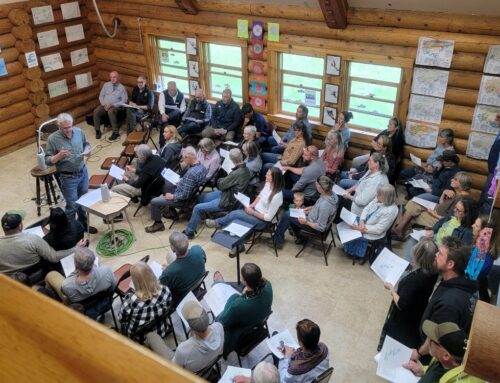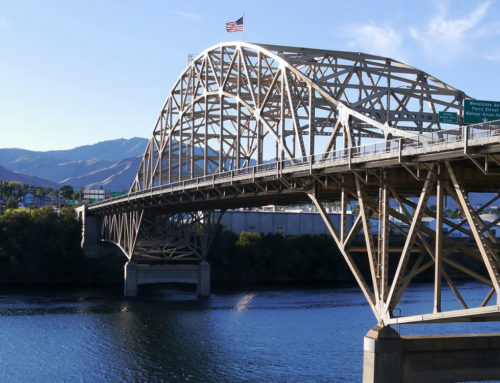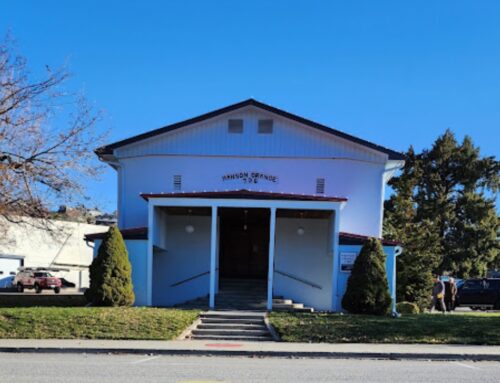Highway 97 and 97-A rank among the highest number of wildlife incidents in the state
information released by Washington Fish & Wildlife, Genie Carey photo
The number of wildlife hit by vehicles on Washington roadways is staggering: A safety message from the Washington Department of Fish and Wildlife
Try using a little less pressure on the accelerator this fall when driving; deer are especially active in November as the rut (mating season) is at its peak. Additionally, many animals from each of Washington’s three deer species are migrating from high country to lower elevations where they spend the winter. During this time, it also starts getting dark earlier. This all adds up to the need for drivers to slow down and be extra vigilant, to protect both themselves and deer.

Deer and other cervids (elk, moose, and caribou) in North America accumulate and store nutritional reserves during the summer and fall, and mostly live off those reserves over the winter. This means they are working hard to store up fat reserves now by moving to areas where foraging is better, to balance activity versus energy reserves when the weather cools down.
“Migratory deer in central Washington leave their summer ranges during this time of year because snow levels are too deep in these areas for them to manage during winter,” said Brendan Oates, ungulate specialist with the Washington Department of Fish and Wildlife (WDFW). “The quality of vegetation available for forage on winter range is nowhere close to what it is on summer range.”
Around central and eastern Washington, this includes mule deer and some white-tailed deer moving down from the Cascades, Kettle Range, Selkirks, and Blue Mountains to winter ranges in the valleys and Columbia Basin shrubsteppe. In Western Washington, certain groups of black-tailed deer migrate from summer ranges high in the Cascade and Olympic Mountains to spend the winter in lower elevation forests and valleys.
In the process of this move from one range to another, deer often cross busy highways. Roadways with high traffic volumes create barriers to habitat connectivity and can force deer into dangerous situations with vehicles, as well as endanger human lives.

Deer also become less attentive to potential danger during the rut as they are focused on finding a mate and are more prone to jumping out in front of a vehicle. The time change associated with daylight saving time can also take a toll on deer. Deer are crepuscular (i.e., most active at dawn and dusk). With more people driving after dark and before sunrise in the late fall and winter, it is important to be especially watchful and drive carefully during these times.
Collisions with deer and wildlife species of all kinds are tracked through three sources by the Washington State Department of Transportation (WSDOT), and the numbers are staggering:
Collision reports
Local law enforcement agencies and the Washington State Patrol submit collision reports to WSDOT. Nationwide, it is estimated that 1 million deer–vehicle collisions occur annually, with an associated cost of more than $1 billion in vehicle damages and 29,000 human injuries.
Carcass removal records
WSDOT maintenance crews remove roadkill from state highways and have been tracking the number of carcasses, including deer and elk, since the mid-1970s. Data from those efforts suggest that around 5,000 collisions with deer and nearly 300 collisions with elk occur each year. Numbers from 2018 through 2022 estimate that there are 13,382 annual deer-vehicle collisions when a correction factor is applied to account for animals that are hit by vehicles but not discovered or reported by road crews (this number doesn’t include elk, moose, or other species).

The average cost of a deer-vehicle collision was estimated at $14,014 per collision in 2022. That adds up to over $187 million per year in damages and other costs associated with deer-vehicle collisions on Washington highways.

Community salvage records
In most counties, WDFW allows members of the public to legally salvage road-killed deer and elk as long as they obtain a salvage permit within 48 hours of picking up a carcass (salvaging roadkill in Clark, Cowlitz, and Wahkiakum counties is not allowed due to the presence of the federally-protected Columbian white-tailed deer subspecies). WDFW also asks salvagers to have their deer or elk tested for chronic wasting disease. Salvage data collected by WDFW is provided to WSDOT for their tracking purposes.
During the first full six years of legal salvage (2017–2022), community members reported the removal of 4,876 deer and 1,584 elk from Washington highways. This represents 18% of total deer carcass removals and 63% of total elk carcass removals over the same time period.

All of the data gathered through these three sources is analyzed to pinpoint deer-vehicle collision locations and helps engineers develop safety plans to reduce collisions.
“For the first time, the federal government has created funding mechanisms intended to reduce wildlife-vehicle collisions and increase habitat connectivity, which will be allocated on a competitive basis,” said Glen Kalisz, Habitat Connectivity Biologist with WSDOT. “This data not only helps us identify and mitigate the worst wildlife-vehicle collision locations in the state, but also gives us a competitive edge when applying for those funds.”
It also informs drivers where to be the most vigilant to the presence of both deer and elk, such as the following areas with some of the highest wildlife-vehicle interactions in the state:
Eastern Washington
- State highways north of Spokane, such as US 395 from Chewelah north to Kettle Falls and US 2 from North Spokane to Cusick where highways intersect with white-tailed deer wintering grounds. US 2 north of Spokane is also a moose collision hotspot.
- State routes 124 and U.S. 12 in southeast Washington where the roadways follow the Touchet River Valley from about Lamar up to the intersection with Highway 261. This area has an abundance of white-tailed deer.
- I-90 in the vicinity of the town of Sprague experiences deer, elk, and moose-vehicle collisions. A human fatality involving a moose collision was recently reported in this area.
Central Washington
- Busy highways north and west of Wenatchee, specifically Highway 97 near Blewett Pass and along the Okanogan and Columbia Rivers, particularly between the towns of Riverside and Tonasket where wildlife crossing and fencing projects are underway. There is an abundant mule deer population outside of the city.
- U.S. 97 north of Goldendale.
- I-90 in the Easton/Cle Elum vicinity and the Ryegrass to Vantage area. Ryegrass to Vantage has the highest number of elk/vehicle collisions on the east side of the state.
Western Washington
- Along State Routes 20 and 525 on Whidbey Island.
- Areas where highways intersect the Cascade Mountains such as US Highway 12 in the Packwood-Randle vicinity as well as near Satsop and Montesano, on State Route 20, and on I-90 near North Bend. These are all elk-vehicle collision hotspots.
- Highways 101 and 4 close to Willapa Bay. This area has high rates of collisions involving elk.
- US Highway 101 between Port Angeles and Sequim experiences high levels of deer-vehicle collisions by western Washington standards.
- Interstate 5 in southwest Washington experiences above average wildlife-vehicle collision rates, particularly with black-tailed deer. While collision rates in this location are not as high compared to some others, the high volume of traffic and speed of travel merit this location’s inclusion.
While deer and elk are the most common roadkill collected, please be alert for other wildlife crossing roadways as well. While all large animals are considered together for the map of large animal-vehicle collisions, the results are driven by deer collisions, which equaled over 80% of the total records.

Tips to avoid collisions with wildlife
WSDOT has some design tactics it uses to encourage animals to stay off highways — primarily wildlife fencing and wildlife crossings — which consistently reduce wildlife-vehicle collisions by 80–90% when deployed together and allow unencumbered wildlife movement across roads.

Even so, drivers are recommended to use the following preventative measures to avoid hitting wild animals:
- Slow down and be extra alert for wildlife, especially during the rut and migration season in the fall and in the spring when fawns follow does across roads.
- Deer often move in small herds so seeing one deer is often an indicator that more deer may be present. If you stop to let a deer cross the road, pause long enough to ensure that more aren’t following.
- Treat the road shoulder like an extra traffic lane. Be on the lookout for animal activity as if they represent merging traffic.
- Headlights confuse deer and may cause them to move erratically or stop. If you see a deer on the side of the road or in front of you, be prepared for it to potentially approach your vehicle.
- If a collision with a deer seems imminent, take your foot off the accelerator and brake lightly. Keep a firm hold on the steering wheel while keeping the vehicle straight. Do not swerve in an attempt to miss the deer. Studies show that more serious crashes occur when drivers swerve to avoid an animal as it could cause you to lose control of your vehicle and possibly roll over or hit another car or object.
- If you accidentally hit and kill a deer, move the animal off the road if you can do so safely, then report the collision to the appropriate authority. Do not try to remove dead animals from a high traffic roadway due to safety concerns. Instead, report the collision to law enforcement and let them know the carcass is still in the roadway. They will alert WSDOT staff to safely remove it.
Learn more about work by WDFW, WSDOT, and other partners for wildlife crossings and habitat connectivity in this recent video and this July 2023 blog post.








